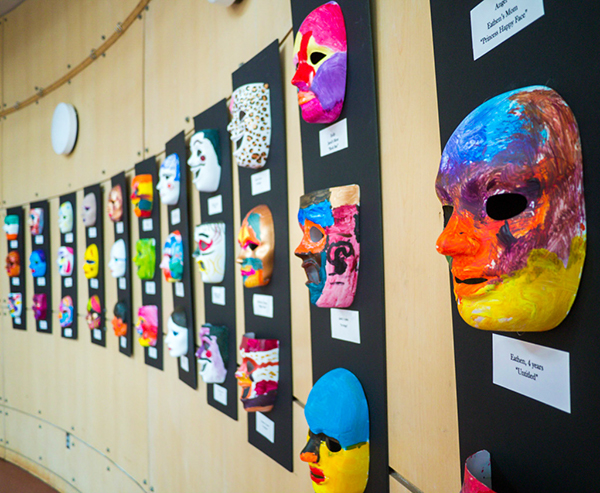

Colorful assortments of masks lined the walls of the Fine Arts Building, gazing silently upon the crowd gathered before them.
Each meticulously placed brush stroke and pattern evokes the feelings of children facing various illnesses. Creative arts therapist and New Paltz adjunct Lucy Barbera, Ph.D., reflected on the mask paintings, which she said helped alleviate the fear and pain her patients suffered.
“Masks of Hope and Healing,” an exhibition featuring mask paintings created by pediatric patients of the Children’s Hospital at SUNY Upstate Medical University in Syracuse during Barbera’s creative art therapy sessions, was displayed for the first time on the SUNY New Paltz campus on Thursday, April 24.
“A mask is very powerful [in art]. It’s three-dimensional and it’s personal. It is a canvas that is literally a face,” Barbera said. “That combination is so powerful you can make that mask into anybody or any force that your imagination can dream of.”
Masks — physical devices most often used to conceal the tangible — are conversely used to reveal the emotional. Having previously used mask art in her therapy sessions, Barbera found their use to elicit strong responses in patients due their intrinsic nature as “canvases of alter-ego projection.”
Barbera worked as a medical art therapist at the Children’s Hospital beginning in May of 2012 and by October 2012 would first mount her patients’ mask art at the Children’s Hospital.
In a lecture presented before the exhibition opening on Thursday titled “Art Therapy with Pediatric Patients: Healing Process, Healing Image,” Barbera spoke on the psychology behind mask design.
According to Barbera, the design and themes patients painted on their masks were often reflective of the emotional support they craved, be it a protective force, a transformational proxy, a reminder of self or other self-serving devices.
Barbera recalled working with mental health patients who she instructed to paint a series of two masks; one representative of where they currently were psychologically and another mask representing where they hoped to be in the future.
“I realized the transformational power, how much they projected onto that mask and how much that mask served as a reminder to themselves of their own heroism,” Barbera said.
Barbera’s definition of art therapy is “the wedding of two vital disciplines, psychology and art, to provide multiple modalities, often non-verbal, as alternative means of communication and expression to facilitate physical, emotional, social and psychological healing.”
Barbera said children are comfortable participating in art therapy because they have positive and familiar associations with creative craft — something that provides a comforting reprise from trauma experiences that can result from hospitalization.
“When they take their art home, the masks serve as a bridge between the patient’s experience in the hospital and home,” Barbera said. “Even though some of them look scary, creating them was liberating because the patients were able to release negative emotions and fears. The masks carry a positive healing message and a record of self.”
Barbera said by allowing patients an opportunity to take an active role in their recovery, they are empowered in an environment where many decisions remain entirely out of their control.
“Saying ‘no’ is often the power hospitalized individuals have — be it in response to treatments or therapy,” Barbera said. “Becoming involved in your own treatment helps in the process of getting well.”
